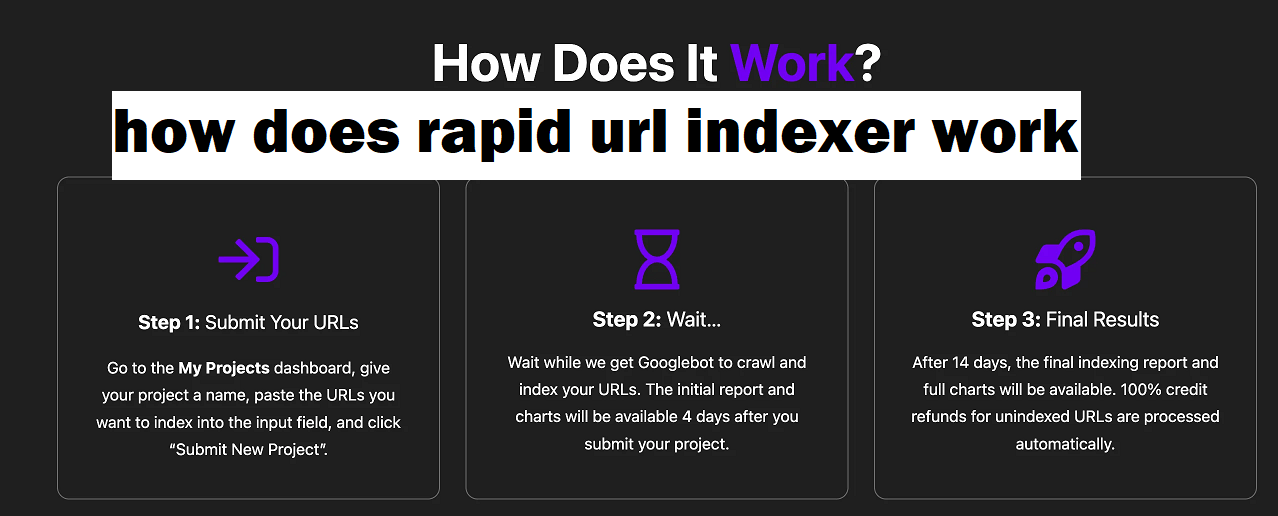In the ever-expanding digital landscape, ensuring that a website is properly indexed by search engines like Google, Bing, or Yahoo is crucial for visibility and SEO success. One of the most effective tools for speeding up this process is a Rapid URL Indexer. This service or software helps website owners, SEO professionals, and digital marketers quickly submit URLs to search engines for faster indexing. But how does rapid url indexer work exactly does it work? Let’s break down the process.
What is URL Indexing?
Before diving into how a Rapid URL Indexer works, it’s essential to understand what indexing means. Search engines use web crawlers (also called bots or spiders) to visit websites and gather information. When a page is “indexed,” it means that the search engine has visited the site, understood its content, and stored it in its database, making it eligible to appear in search results.
Without proper indexing, your site won’t appear in search engine results pages (SERPs), even if it’s well-optimized. Search engines don’t automatically index all new web pages, especially if they’re part of a new or low-authority domain, which can make rapid indexing tools a necessity.
What is a Rapid URL Indexer?
A Rapid URL Indexer is a tool designed to accelerate the process of getting URLs indexed by search engines. Instead of waiting for crawlers to naturally find and index your new or updated web pages (which could take weeks or even months), a rapid indexer sends requests to search engines, notifying them of the URLs that need attention.
These tools typically use several techniques to draw the attention of search engine crawlers to your site more quickly, helping to prioritize the indexing process.
How Does It Work?
- Submission to Web 2.0 Platforms
Many rapid indexers leverage Web 2.0 sites like blogging platforms, forums, and social bookmarking sites. These platforms are often indexed quickly by search engines because they have high domain authority. By creating backlinks or placing the URLs on such sites, search engine crawlers can find the new URL more quickly. - Pinging Services
A key method that rapid indexers use is pinging. Pinging notifies search engines that new content is available for crawling. The indexer submits the URL to various pinging services, which act as signals to alert search engines to revisit the website and its new pages. - RSS Feeds
RSS feeds (Really Simple Syndication) are another technique. When URLs are added to an RSS feed and submitted to aggregators or feed services, it can attract the attention of crawlers. Search engines regularly check these feeds for new content, helping your URLs to be indexed more quickly. - API Integration with Search Engines
Some rapid indexers integrate directly with search engine APIs like the Google Indexing API. This allows the tool to notify Google about new content or changes, prompting faster crawling and indexing. Google, for example, allows users to submit up to 200 URLs per day via the API, which can be a major advantage in large-scale operations. - Social Signals
Many indexers also use social media platforms to generate attention. URLs shared on platforms like Twitter, Facebook, or Reddit tend to be crawled quickly. By promoting a new URL on these networks, search engines are more likely to find and index the page sooner. - Backlinks Creation
High-quality backlinks are a well-known SEO practice, and rapid indexers often automate this process. By creating backlinks from high-authority websites, search engines are more likely to visit your new page and index it faster.
Benefits of Using Rapid URL Indexers
- Time Efficiency
Without a tool like a rapid indexer, it can take weeks or months for a page to be indexed, especially on low-authority or newly established websites. Rapid URL indexers drastically reduce this time, often helping your page get indexed in a matter of hours or days. - Better SEO Performance
Faster indexing means that your content is visible in SERPs sooner. This is especially important for time-sensitive content, like news articles or product releases, where early visibility is crucial for ranking success. - Automated Processes
Many rapid indexers offer automated submission processes, where you simply input the URLs you want indexed, and the tool handles the rest. This automation saves significant time and effort compared to manual URL submission. - Improved Crawl Rate
Frequent use of rapid indexers can improve your site’s crawl rate. Search engines will recognize that your site frequently adds or updates content, leading them to crawl it more often.
Potential Drawbacks
While rapid URL indexers can be incredibly helpful, they are not without drawbacks:
- Overuse and Spam Signals
Aggressive use of pinging, RSS submissions, or backlinks from low-quality sites may trigger spam signals, potentially leading to penalties from search engines. - Temporary Boost
Some rapid indexers might only provide a temporary indexing boost. After the initial crawl, the page might not be re-crawled if the content isn’t deemed high-quality or relevant by the search engine’s algorithms. - Reliability Varies
The effectiveness of rapid indexers can vary based on the quality of the tool, the techniques used, and the ever-evolving search engine algorithms. Some services may promise rapid indexing but fail to deliver consistent results.
Conclusion
A Rapid URL Indexer is a valuable tool for website owners and SEO professionals looking to get their content indexed quickly by search engines. By using methods like Web 2.0 submissions, pinging services, and social signals, these tools can help accelerate the indexing process, giving your content a competitive edge in appearing on search engine results pages. However, it’s essential to use such tools wisely to avoid over-optimization or spam penalties, ensuring that the long-term SEO strategy remains solid.
Read more:
2-https://rapidurlindexer.net/blogs/backlink-indexer-and-rapid-url-indexer-maximizing-seo-efficiency/
3- https://rapidurlindexer.net/blogs/rapid-url-indexer-login-a-quick-guide-for-seos-and-webmasters/
4- https://rapidurlindexer.net/blogs/website-indexer-rapid-url-indexer/
5- https://rapidurlindexer.net/blogs/backlink-indexing-a-guide-to-rapid-url-indexer/
6- https://rapidurlindexer.net/blogs/seo-new-york-rank-faster-with-rapid-url-indexer/
7- https://rapidurlindexer.net/blogs/how-does-rapid-url-indexer-work/
8- https://rapidurlindexer.net/blogs/seo-tools-like-rapid-url-indexer-a-comprehensive-guide/
9- https://rapidurlindexer.net/blogs/what-is-rapid-url-indexer/
10- https://rapidurlindexer.net/blogs/seo-software-rapid-url-indexer/

Leave a Reply